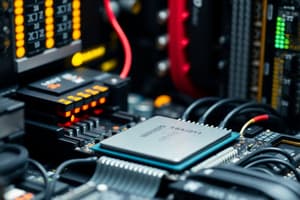Podcast
Questions and Answers
What was a significant advantage of 2nd generation computers over their predecessors?
What was a significant advantage of 2nd generation computers over their predecessors?
- They were smaller and cheaper. (correct)
- They used integrated circuits.
- They had increased heat dissipation.
- They employed advanced Artificial Intelligence.
Which of the following features was introduced with the IBM 7094?
Which of the following features was introduced with the IBM 7094?
- Data Channel. (correct)
- Personal computing capabilities.
- Integrated circuits.
- Use of microprocessors.
What is one of the main characteristics of 3rd generation computers?
What is one of the main characteristics of 3rd generation computers?
- They used vacuum tubes.
- They utilized Small Scale Integration. (correct)
- They had a broader range of analog components.
- They were larger than previous generations.
Which computer is known for being compact enough to fit on a lab bench?
Which computer is known for being compact enough to fit on a lab bench?
What trend characterized the transition into 4th generation computers?
What trend characterized the transition into 4th generation computers?
What technology did first generation computers primarily rely on for their operation?
What technology did first generation computers primarily rely on for their operation?
Which of the following is a characteristic of the Von Neumann Machine?
Which of the following is a characteristic of the Von Neumann Machine?
What was a major disadvantage of the ENIAC computer?
What was a major disadvantage of the ENIAC computer?
Which computer is noted for being the first commercial computer?
Which computer is noted for being the first commercial computer?
What significant development happened with the introduction of second generation computers?
What significant development happened with the introduction of second generation computers?
Flashcards are hidden until you start studying
Study Notes
Evolution of Computer Systems
- Computer systems have transformed from manual counting and paper calculations to sophisticated digital machines.
- The evolution includes advancements in the Central Processing Unit (CPU), memory technologies, multicore, MICS, GPU, and embedded systems.
Early Computer Tools
- Initial tools for computation included manual counting and the abacus, representing humanity's first attempts at calculation.
- The need for computers arose from handling large datasets and performing complex calculations efficiently.
Generations of Computers
First Generation Computers
- Utilized vacuum tubes for circuitry and memory storage.
- ENIAC: Built in 1946, capable of 5,000 additions per second; comprised 18,000 vacuum tubes, weighing 30 tons, and occupying 1,500 square feet.
- Von Neumann Machine: Developed in 1946, known as the IAS computer; introduced the stored-program concept.
- UNIVAC I: First commercial computer created in 1947 by Eckert and Mauchly; focused on matrix and statistical computations.
- IBM 701: Launched in 1952, featured electronic stored-program and punch card inputs.
Second Generation Computers
- Transitioned to using transistors instead of vacuum tubes, leading to smaller and cheaper machines with reduced heat output.
- Notable systems included PDP-1 by DEC (1957) marking the onset of mini-computers and IBM 7094, which increased memory and instruction codes significantly.
Third Generation Computers
- Employed Integrated Circuits (ICs) that combined transistors and other components into a single unit.
- Benefits included reduced size, cost savings, increased operating speed, and improved reliability.
- IBM System/360: Released in 1964, showcasing advancements in speed, memory, and I/O ports.
- PDP-8: Introduced by DEC in 1964 as a compact, lab-friendly computer.
Fourth and Later Generations
- Characterized by using densely packed ICs and the introduction of microprocessors.
- Intel 4004: The first microprocessor developed in 1971, integrating all CPU components; followed by the Intel 8008 (8-bit).
- Advancements in microarchitecture led to Pentium Pro (1995) and Core i7 EE 990 (2011), demonstrating increasing transistor counts.
Moore’s Law
- Predicts that the number of transistors in a dense integrated circuit doubles approximately every two years, driving technology advancements.
Fifth Generation (2010-Present)
- Focuses on superconductors, Artificial Intelligence (AI), Natural Language Processing (NLP), and parallel processing.
- Future technologies anticipated include nanotechnology and quantum computation.
Evolution of Memory
- Early memory devices included core memory made of tiny ferromagnetic rings, used during the 1950s and 1960s.
Studying That Suits You
Use AI to generate personalized quizzes and flashcards to suit your learning preferences.




